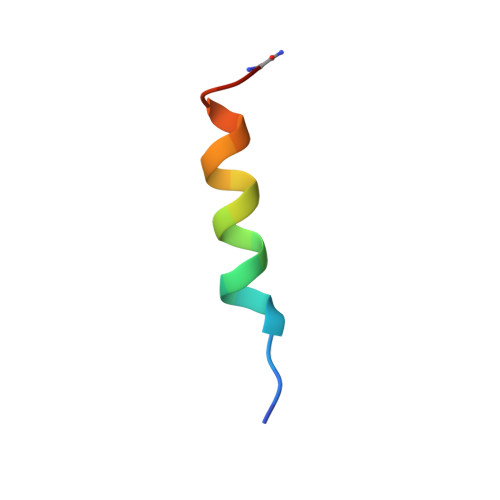Solution NMR structures of the antimicrobial peptides phylloseptin-1, -2, and -3 and biological activity: The role of charges and hydrogen bonding interactions in stabilizing helix conformations
Resende, J.M., Moraes, C.M., Prates, M.V., Cesar, A., Almeida, F.C., Mundim, N.C., Valente, A.P., Bemquerer, M.P., Pilo-Veloso, D., Bechinger, B.(2008) Peptides 29: 1633-1644
- PubMed: 18656510
- DOI: https://doi.org/10.1016/j.peptides.2008.06.022
- Primary Citation of Related Structures:
2JPY, 2JQ0, 2JQ1 - PubMed Abstract:
Phylloseptins are antimicrobial peptides of 19-20 residues which are found in the skin secretions of the Phyllomedusa frogs that inhabit the tropical forests of South and Central Americas. The peptide sequences of PS-1, -2, and -3 carry an amidated C-terminus and they exhibit 74% sequence homology with major variations of only four residues close to the C-terminus. Here we investigated and compared the structures of the three phylloseptins in detail by CD- and two-dimensional NMR spectroscopies in the presence of phospholipid vesicles or in membrane-mimetic environments. Both CD and NMR spectroscopies reveal a high degree of helicity in the order PS-2> or =PS-1>PS-3, where the differences accumulate at the C-terminus. The conformational variations can be explained by taking into consideration electrostatic interactions of the negative ends of the helix dipoles with potentially cationic residues at positions 17 and 18. Whereas two are present in the sequence of PS-1 and -2 only one is present in PS-3. In conclusion, the antimicrobial phylloseptin peptides adopt alpha-helical conformations in membrane environments which are stabilized by electrostatic interactions of the helix dipole as well as other contributions such hydrophobic and capping interactions.
Organizational Affiliation:
Universidade Federal de Minas Gerais, Departamento de Química, Avenida Presidente Antonio Carlos 6627, 31270-901 Belo Horizonte, MG, Brazil.














